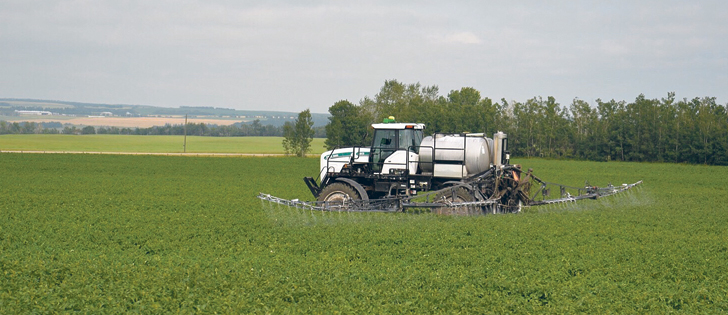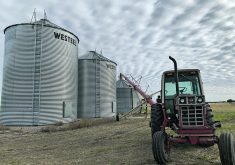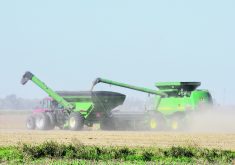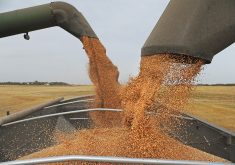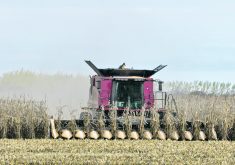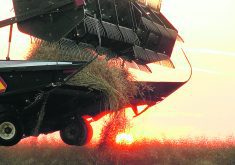MANITOBA
SOUTHWEST
Precipitation was 15 to 40 millimetres, and lodging is visible in some fields.
Winter wheat harvest is underway with 65 bushel per acre yields.
Some areas are spraying to control diamondback moths and bertha armyworms.
NORTHWEST
Rainfall was five to 35 mm, and crops and soil moisture conditions are rated adequate to fair.
Native hay harvest is 75 percent complete with above average yields, while second cut hay yields are below average.
Cereal silage harvest has average to above average yields.
Read Also

Manitoba community projects get support from HyLife
HyLife Fun Days 2025 donated $35,000 each to recreation and housing projects in Killarney, Steinach and Neepawa earlier this fall.
CENTRAL
Precipitation varied from 10 to 25 mm with high temperatures.
Harvest began in fall rye, winter wheat and barley, which had excellent yield and quality.
Aphid numbers are increasing in potatoes; other crops are maturing and spraying continues for late blight.
EASTERN
Rainfall was two to 40 mm with severe thunderstorms and hail.
Some cattle are being moved to areas of re-growth as pasture conditions are rated 60 percent good, 20 percent fair and 20 percent poor.
Hay fields are rated 80 percent good and 20 percent fair.
INTERLAKE
Precipitation varied from .3 to 25 mm.
Harvest has started on winter wheat, early barley and peas.
Grass seed harvest continues while perennial ryegrass is being swathed and combined.
SASKATCHEWAN
SOUTHEAST
Four percent of the crop is combined with three percent swathed or ready to be straight cut, and yields are average to below average.
Precipitation varied from trace amounts to 40 mm.
Topsoil moisture is rated 22 percent adequate, 48 percent short and 30 percent very short, while hayland and pasture is 12 percent adequate, 48 percent short and 40 percent very short.
SOUTHWEST
Ninety-six percent of fall rye, 33 percent of winter wheat, 23 percent of field peas, 13 percent of lentils and one percent of mustard, durum and barley are now in the bin, while seven percent of mustard and four percent of canola are swathed.
Rainfall ranged from trace amounts to 30 mm along with strong winds and heat.
Haying has generally wrapped and lower than normal yields is resulting in a shortage of hay.
EAST-CENTRAL
Four percent of winter wheat and two percent of lentils and field peas are combined, and pulses are being desiccated.
Precipitation varied from trace amounts to 30 mm along with strong winds and hail.
Topsoil moisture on cropland is rated 40 percent adequate, 37 percent short and 22 percent very short, while hayland and pastures are 31 percent adequate and 42 percent short.
WEST-CENTRAL
Twenty-nine percent of fall rye, 23 percent of winter wheat and one percent of field peas are in the bin, while two percent of canola has been swathed.
Rainfall ranged from trace amounts to 32 mm along with strong winds and hail.
Topsoil moisture on cropland is rated as 29 percent adequate, 49 percent short and 22 percent very short, while hayland and pastures are 28 percent adequate, 37 percent short and 35 percent very short.
NORTHEAST
Precipitation varied from trace amounts to 26 mm along with strong winds and hail.
Topsoil moisture on cropland is rated three percent surplus, 75 percent adequate and 21 percent short, while hayland and pastures are two percent surplus, 73 percent adequate and 24 percent short.
Haying is are wrapping up and yields are about normal.
NORTHWEST
Rainfall ranged from trace amounts to 80 mm along with strong winds and hail, which flooded and lodged some crops.
Yields are expected to be about average overall, but some areas may see above-average yields due to timely moisture.
Topsoil moisture conditions on cropland, hayland and pastures have an average rating of 14 percent surplus, 69 percent adequate, 12 percent short and five percent very short.
ALBERTA
SOUTH
Yields are generally below average with about 14 percent of crops in the bin and another nine percent in the swath.
Diamondback moths, lygus bugs and gophers exceed threshold levels.
First cut haying for both dryland and irrigated land is virtually done with 87 and 93 percent good to excellent quality, while pasture conditions are 81 percent poor to fair and 19 percent good to excellent.
CENTRAL
Fifteen percent of winter wheat and 14 percent of rye are either combined or swathed.
The diamondback moth population is about 13 percent moderate and 18 percent over the threshold.
Quality of first cut hay is rated 79 percent good to excellent for dryland hay and 90 percent for irrigated.
NORTHEAST
Unharvested fields from last season and unseeded ones remain too soft for equipment.
Diamondback moths are 17 percent moderate and five percent over threshold populations, while gophers are three percent over threshold.
Average yield is estimated at 1.9 tons per acre for dryland hay with quality rated at 79 percent good to excellent, while pastures average 15 percent fair, 43 percent good and 40 percent excellent.
NORTHWEST
Rain and hail restricted the forage harvest in some areas.
Grasshoppers are 49 percent moderate and 11 percent over the threshold population.
Average yield for first cut hay is about 2.1 tons per acre with quality rated at 75 percent good to excellent, while pastures average 14 percent fair, 37 percent good and 48 percent excellent.
PEACE
Lack of moisture and warm weather have hurt some crops, and spring cereals are mostly at the milk development stage.
The grasshopper population is eight percent moderate and four percent over the threshold.
Average yield of first cut hay is about 1.3 tons per acre, and pasture conditions are 24 percent poor to fair and 76 percent good to excellent.

